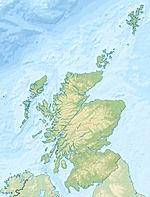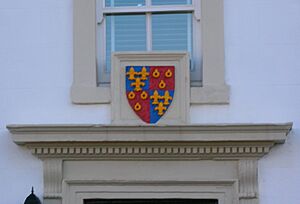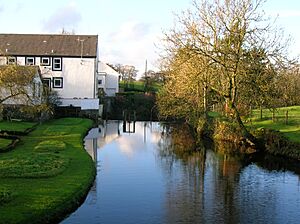Polnoon Castle facts for kids
Quick facts for kids Polnoon Castle |
|
|---|---|
| Eaglesham, East Renfrewshire, Scotland UK grid reference NS58505132 |
|
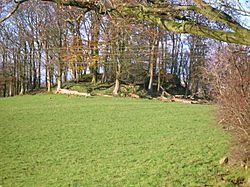
Polnoon Castle mound
|
|
| Coordinates | 55°44′05″N 4°15′18″W / 55.7346°N 4.2551°W |
| Type | Tower |
| Site information | |
| Owner | Polnoon Farm |
| Controlled by | Montgomery clan |
| Open to the public |
Private |
| Condition | Significant rubble remains |
| Site history | |
| Built | 14th century |
| Built by | Sir John Montgomery |
| In use | Until 17th century |
| Materials | stone |
| Top - 0-9 A B C D E F G H I J K L M N O P Q R S T U V W X Y Z |
Polnoon Castle was a strong fortress built in the 14th century. It stood on a small hill, called a motte, next to the Polnoon Water in Millhall, Scotland. This castle was the home of the powerful Montgomery family.
The Montgomery Family of Eaglesham
The land of Eaglesham became part of the Montgomery family's property a long time ago. Records show that a Robert of Montgomery was an important tenant around 1160.
Later, in 1296, John de Montgomery and his brother officially promised their loyalty to King Edward I of England for their lands. This was recorded on something called the Ragman Roll.
A Hero at the Battle of Otterburn
A famous member of the family was Sir John Montgomery, the ninth Baron of Eaglesham. He was a hero at the Battle of Otterburn in 1388. In a brave one-on-one fight, he captured Sir Henry Percy, a famous English knight nicknamed 'Hotspur'.
In those days, it was common to capture important enemies and then release them for a large payment, called a ransom. Sir John used the money he received for Hotspur's release to build a magnificent castle at Polnoon. It's even said that Sir Henry Percy, impressed by Sir John's honorable treatment, might have helped with the castle's design!
The story of their fight is told in an old poem called 'The Battle of Otterburne':
|
The Percy and Montgomerie met, Yield thee, yield thee, Percy, he said, As soon as he knew it was Montgomerie, |
Sadly, Sir John's son, Sir Hugh Montgomery, was killed at the Battle of Otterburn by an arrow. His death is mentioned in another poem, 'The Ballad of Chevy Chase':
|
He had a bow bent in his hand, Against Sir Hugh Montgomerie |
Hugh's body was taken to Edinburgh Castle. The flag and spear captured from Percy were also brought there. These trophies are still with the Montgomery family today. Hugh was buried in the Skelmorlie Aisle of Largs Old Kirk in Largs.
Family Connections
The Montgomery family became even more powerful through important marriages. In 1368, John de Montgomery married Elizabeth, who was the daughter of Sir Hugh Eglinton. She was also related to King Robert II. This marriage brought the lands of Eglinton and Ardrossan into the Montgomery family.
What Does 'Polnoon' Mean?
The name 'Polnoon' might come from an old Scottish word 'poinding', which means a ransom. This would connect it to Sir John Montgomery's famous ransom of Hotspur. However, 'Pol' could also mean a pool in a river, like the one near the castle site. Old maps and books show the name written in different ways, like 'Pounuyn' or 'Punoon'.
The Castle's Location and What it Looked Like
Not many pictures of Polnoon Castle exist. An old map from 1799 shows the castle as ruins. Another map from 1654 shows Polnoon as a main house with two smaller buildings on each side, connected by a fence.
The castle's mound is about a mile south of Eaglesham church. It sits on a high point, offering great views of the countryside. The mound is rectangular, about 30 by 22 meters at the bottom and 18 by 10 meters at the top. It is at least 4 meters high. It might have been built for an even older castle.
Today, very little of the castle remains standing. Large pieces of stone are scattered around the site and in the Polnoon Water. On the west side, the ground drops steeply down to the Polnoon Water. This water joins the White Cart nearby.
It is said that Sir John Montgomery had a carving of a spur (like a knight's spur) placed above the castle door. This was to remember his capture of Sir Henry 'Hotspur' Percy.
Castle Relics and Symbols
The Montgomery family's coat of arms, which was once above the castle entrance, can now be seen above the door of the old Cross Keys Inn in Eaglesham. This coat of arms combines symbols from the Montgomery family (the fleurs-de-lis) and the Eglinton family (the signet rings).
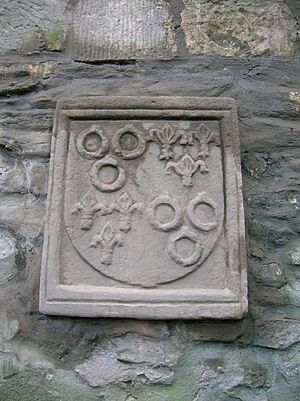
Other items from the castle have been moved over time. The old castle doors are said to be in a museum in Edinburgh. A stone from the castle with a Masonic symbol is used as a gravestone in the churchyard. A piece of furniture from the castle is in the Glasgow Art Gallery.
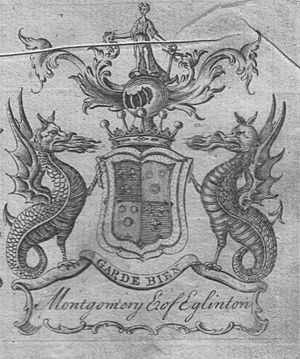
Why the Castle Fell Apart
After the Montgomery family married into the Eglinton family, Eglinton Castle became their main home. Polnoon Castle became less important. Especially after Hugh, the fifth Lord Montgomery, became the Earl of Eglinton in 1503.
Polnoon Castle was fixed up in 1617, but by 1676, it was already a ruin. It quickly fell apart, probably because people took its stones to build new houses in the nearby village of Eaglesham in the 1700s. An old map from 1654 shows the castle still standing, but a map from 1796 shows it as ruins.
Polnoon Lodge in Eaglesham was built as a hunting lodge in the early 1700s, after Polnoon Castle was no longer used. The original house was built in 1733.
The Area Around Polnoon
Polnoon Farm is located close to the castle site. Old records from 1695 show that the Wallace family owned the farm.
Millhall is a small village across the Polnoon Burn to the west. It grew around the Millhall Mill, which is now private homes. The mill pond and dam are still there.
Moot and Gallows Hills
In the past, every important land area had a special place for its local court meetings, called a moot hill. It also had a gallows hill, where punishments were carried out. For the Eaglesham area, the Castle Hill, or the Deil's (Devil's) Planting, might have been the moot hill. This is a tree-covered hill near Castlehill Farm. Another nearby hill called Gallowshill was likely where executions happened.
Micro-history
The names of places like Mid and High Boreland suggest they were linked to a nearby castle. 'Boreland' meant land given to servants or land used to grow food for the castle.
Images for kids


